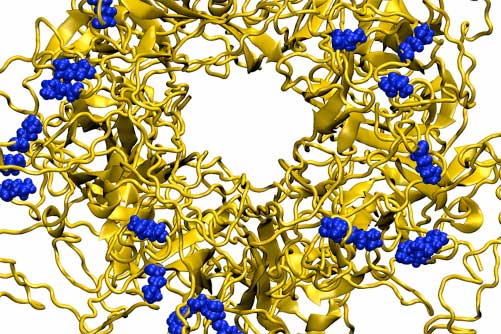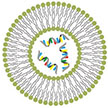| Apr 06, 2022 |
|
|
(Nanowerk Spotlight) Viruses are highly functional nanocarriers that nature has perfected over millions of years. They are programmed to deliver nucleic acids with unprecedented
efficiency and as a result they can infect all types of life forms from plants over animals to humans.
|
|
You might think that viruses exist solely to wreak havoc and cause disease, as is the case with the current COVID-19 pandemic, but that is wrong. First of all, the vast majority of viruses are not pathogenic to humans. Secondly, they many play integral roles in propping up ecosystems and maintain the health of individual organisms – everything from fungi and plants to insects and humans. In a world without viruses, life and the planet as we know it would cease to exist.
|
|
For instance, phages – the viruses that infect bacteria – are the primary regulator of bacterial populations in the ocean, and likely in every other ecosystem on the planet as well. If viruses suddenly disappeared, some bacterial populations would likely explode; others might be outcompeted and stop growing completely.
|
|
Researchers likewise think that viruses are integral for maintaining healthy microbiomes in the bodies of humans and other animals; however, these things are not yet well understood.
|
|
Inspired by viruses’ intricate and highly efficient delivery systems, scientists have put immense efforts into developing artificial nanocarriers with maximal therapeutic efficiency and minimal adverse effects. For this purpose, researchers have been aiming to reach a similar degree of sophistication as natural viruses by developing artificial nanosystems with a wide range of applications – liposomes, polymers, micelles, dendrimers, inorganic nanoparticles made of iron oxide, and more recent hybrid organic-inorganic materials such as metal–organic frameworks (MOFs).
|
 |
| Scheme illustrating various types of organic and inorganic nanoparticles used for vaccine and drug delivery system development. The composition, size, morphology, as well as structure of nanoparticles, have a great impact on their physicochemical properties determining the biomedical applications. (Reprinted with permission by Wiley-VCH Verlag)
|
|
For instance, scientists have discovered a novel system to generate an artificially enveloped oncolytic adenovirus (oncolytic viruses selectively infect and destroy cancer cells) to direct the immune response against cancer.
|
|
These advances have been made possible as chemists learned to synthesize increasingly complex nanoparticles through bottom-up assembly; physicists and engineers have developed methods, mostly using top-down techniques, to fabricate nanoscale materials; and biophysicists and biochemists have had increasing success in manipulating and controlling the interactions at the bio–nano interface.
|
|
Witness the recently developed mRNA-administered vaccines by BioNTech-Pfizer and Moderna in the current SARS-CoV-2 pandemic (read more: “The revolutionary power of bio platforms – or why it took just 48 hours to develop the Covid-19 vaccine“). They are based on lipid nanocarriers that facilitate the delivery of mRNA into cells and exhibit an antiviral efficiency as high as 95% and 94.1%, respectively (read more: “Nanotechnology’s role in the race to find a Covid-19 vaccine“).
|
|
A recent review published in Advanced Functional Materials (“Nanoscience versus Viruses: The SARS-CoV-2 Case”) presents nanoscience in the context of viruses using SARS-CoV-2 as a model example that led to a new research direction.
|
|
Specifically, the article highlights how nanoscience and nanotechnology can solve three acute problems in the treatment, prevention, and diagnosis of viruses like SARS-CoV-2: 1) synthesis of novel drugs and vaccines based on nanocarriers with enhanced efficiency and reduced side-effects for the treatment of the current pandemic and the prevention of future virus attacks; 2) design of protective equipment based on nanoparticles, such as medical face masks and outfits (read our recent Nanowerk Spotlight on nanotechnology for face masks); and 3) development of nanobiosensors for early detection of infections in a maximally efficient way.
|
|
The first major section of the review addresses the development of nano-based vaccines by first describing the types of vaccines, of which many are either currently in use or under development. They include inactivated and live-attenuated vaccines (first generation), subunit, conjugated, and recombinant vaccines (second generation), as well as DNA and RNA vaccines (third generation).
|
 |
| Various vaccine platforms against infectious diseases. Left: 1st generation—live-attenuated and inactivated vaccines. Middle: 2nd generation— subunit and recombinant vaccines, virus-like particles. Right: 3rd generation—DNA and RNA vaccines. (Reprinted with permission by Wiley-VCH Verlag)
|
Next, the authors describe how nanomaterials can improve vaccine responses. For instance, immunogenic nanomaterial-based vaccines must interact with different cell types, such as antigen-presenting cells, B cells, T cells, macrophages, and neutrophils. This interplay can take place in many tissues over extended periods of time, making the rational design of nanomaterial vaccines
a complex endeavor.
|
|
In this type of vaccine, the morphology, and size of nanoparticles, their durability in vivo, the antigen physical orientation, adjuvant specific codelivery, as well as complement activation can be precisely controlled. These parameters affect the vaccine pathway to the different lymphoid tissues, which determine the quality and potency of the immune response.
|
|
The use of stimuli-responsive nanocarriers, i.e. environmentally responsive materials, in the design of new vaccines has also become groundbreaking. These types of smart nanomaterials undergo specific physicochemical changes under the influence of interaction with internal and external stimuli such as changes in pH, temperature, enzymes, redox environment, photo-stimulation, molecule-binding, magnetic fields, ultrasound-stimulation, and electric fields. Moreover, the latest generation of this class of materials incorporates elements that allow for response to multiple stimuli. The result is the ability to deliver immunotherapeutic agents to the disease site or disease-relevant tissues with high spatial and temporal accuracy.
|
|
Another major section of the review deals with the role of nanomedicine in antiviral therapies. Their development, as for vaccines, requires many years of research before they can be widely used due to the series of regulatory steps necessary to establish the efficacy and safety of drugs. However, as the authors note, “after over 200 years of vaccine research, and observing hundreds of thousands of deaths every year as a result of different infectious diseases (where vaccines are available), the need for constantly improving therapies for virus-infected patients is obvious.”
|
|
In recent years, the interest in novel antiviral compounds has grown because they may be less susceptible to resistance and have great potential for use against a wide range of viruses, including new mutations and variants. Both artificial intelligence and other computation tools are largely used to support the development of drugs and delivery systems.
|
|
Nanotechnology provides excellent opportunities to combat viruses both outside and inside the host, which is proven by numerous solutions that have already been applied. As the authors point out, a vast number of promising nanocarrier-based antiviral treatments are currently under investigation to address the limitations of conventional therapy related to heterogeneous drug biodistribution and intracellular trafficking – cell-specific targeting and molecular transport to specific organelles.
|
|
For instance, researchers have developed designer anti-viral nanoparticles that bind to a range of viruses, including herpes simplex virus, human papillomavirus, respiratory syncytial virus and Dengue and Lentiviruses. Unlike other broad-spectrum antivirals, which simply prevent viruses from infecting cells, these novel nanoparticles destroy viruses.
|
 |
| A molecular dynamics model showing a nanoparticle binding to the outer envelope of the human papillomavirus. (Image: Petr Kral, University of Illinois at Chicago)
|
|
A discussion of nanotechnology’s potential to inactivate viruses under different conditions, including self-disinfecting surfaces and personal protective equipment (PPE), makes up another section of the review.
|
|
The final section addresses the development and use of nanobiosensors for diagnosis of viral infectious diseases and pathogenic virus detection. The authors discuss in detail development and use of electrochemical nanobiosensors, optical and magneto-optical nanobiosensors, and piezoelectric immunosensors.
|
|
“Although vaccines against SARS-CoV-2 will strongly decrease the number of new cases, viruses will not disappear,” the authors conclude. “To be prepared for new pandemics, scientists should focus on the improvement of drug delivery platforms that have been proven to be a strong tool to fight against viruses. Nanoscience research can make a great impact in medicine but has to offer elegantly simple solutions based on an inexpensive, reproducible, and high-performance synthesis of the nanoformulations that can be scaled-up by pharmaceutical companies and even modified for other challenges (e.g., other viruses).”
|
By
Michael
Berger
–
Michael is author of three books by the Royal Society of Chemistry:
Nano-Society: Pushing the Boundaries of Technology,
Nanotechnology: The Future is Tiny, and
Nanoengineering: The Skills and Tools Making Technology Invisible
Copyright ©
Nanowerk
|
|
|




